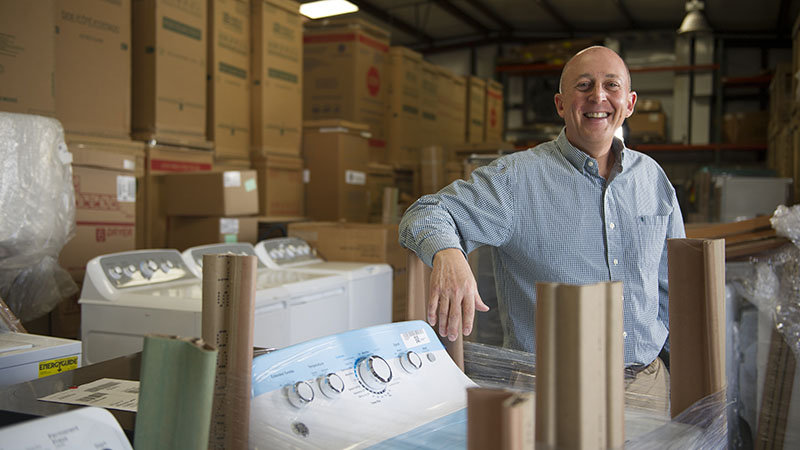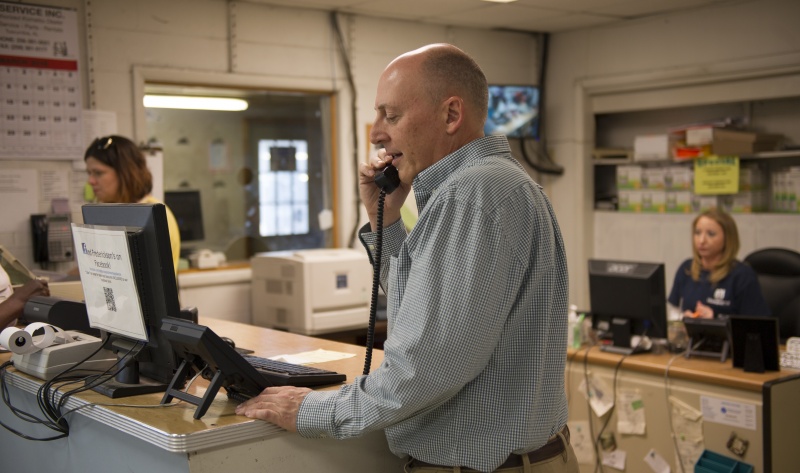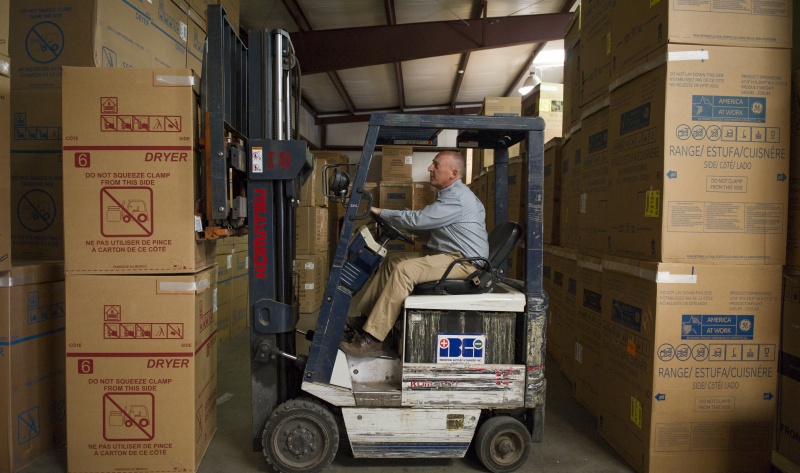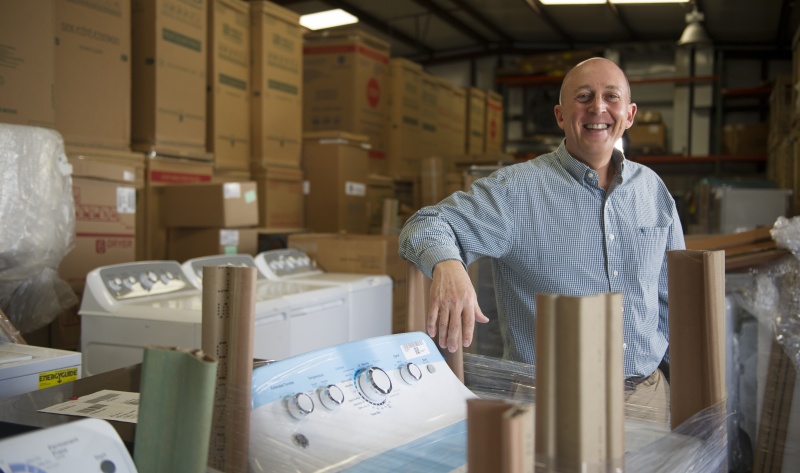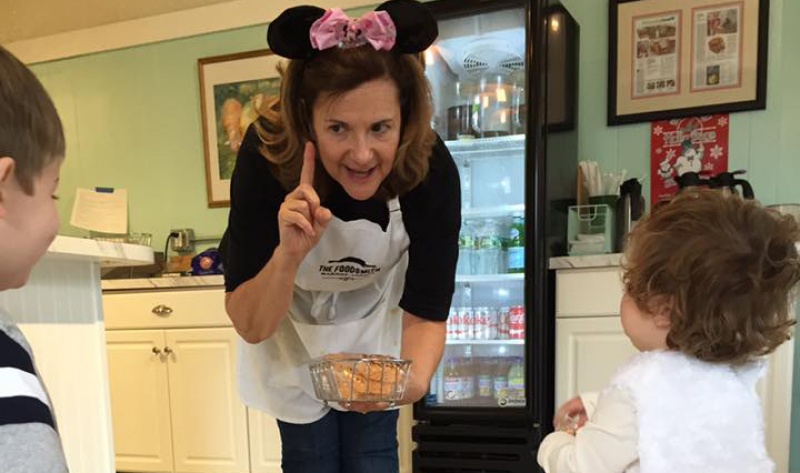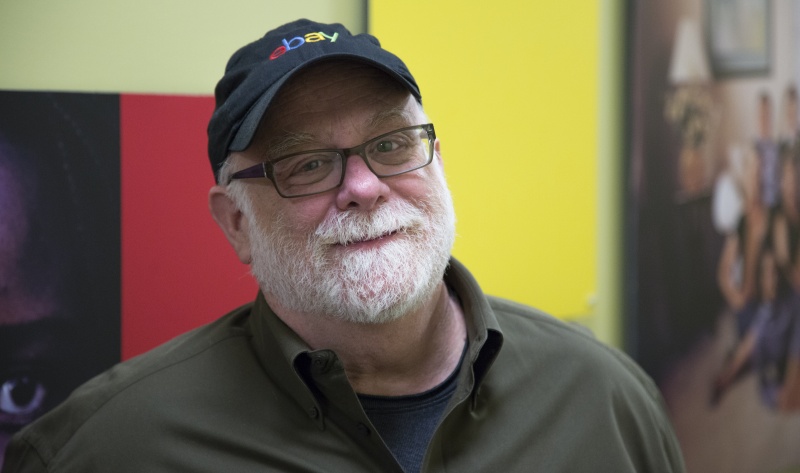Episode Transcript
JOHN HENRY: Laura Raposa runs a small bakery called The Foodsmith in Duxbury, Massachusetts. They’re famous for their sandwiches. They’ve got people who come from all over to get their lobster BLT. Most customers love them, but there’s one customer who was very dissatisfied.
JOHN HENRY: Laura Raposa runs a small bakery called The Foodsmith in Duxbury, Massachusetts. They’re famous for their sandwiches. They’ve got people who come from all over to get their lobster BLT. Most customers love them, but there’s one customer who was very dissatisfied.
LAURA RAPOSA: It was a guy who wrote complaining that his dog Gary didn't like the sandwich that he got from The Foodsmith. Gary had ordered a reuben sandwich without apple slaw. And Gary was disgusted because there wasn’t enough meat in it.
JOHN HENRY: Laura’s sensitive to customer feedback, but she also greets it with a healthy dose of sass. And she could kind of tell that this review was coming from a crank. A very thorough crank.
LAURA RAPOSA: And it just went on and on and on. Let’s see… Okay, “It was given to my dog Gary. It was not a sandwich.” It was, “an empty shell laced with shame.”
I had to print it out, and we read it. We had a dramatic reading for the staff, and this has become a running joke here, is please don’t give anybody a sandwich ‘laced with shame.’
JOHN HENRY: I’m John Henry. And THIS is Open For Business, a branded podcast from eBay and Gimlet Creative about how to build a business from the ground up.
This week: How to succeed at customer service.
Complaining about a sandwich for a dog is pretty funny -- but in reality, if a customer has a bad interaction with your business, it can really hurt. Laura gets that.
LAURA RAPOSA: I hate to say, you know, the customer’s always right, because yes, the customer is always right -- even though they're wrong -- they're always right. And -- and you have to you have to deal with that, because I want to turn you around. I've done it where people have said you know I you know the sandwich didn’t any cheese in it and I really didn’t like it. Like you know what? Here's your money back.
JOHN HENRY: And sometimes, the only way to make people happy is to just admit that they’re right. Even if it means admitting to making a sandwich laced with shame.
LAURA RAPOSA: If you get constructive criticism, you take it as constructive criticism. You don't get get mad at them. You just say, ‘Well, you know what? Maybe that sandwich wasn't the best.’
JOHN HENRY: Customer service is about swallowing your pride, and being prepared to do whatever you need to do in order to send a customer away happy. Because no matter WHAT you do, there are always going to be Garys. The good news is if you prepare in advance, your business will be ready when a Gary the dog does comes along.
This is particularly important because running a business today means you’re dealing in a tech-savvy, rapid response, on-demand world. And that means, there are a different set of challenges than there used to be. Especially if you’re selling online. You can’t just stand in front of your customer and say “Look, I’m human. I’m really sorry.”
So, today we’re going to hear from a couple of business owners who - let’s face it - kind of screwed up. But they also learned valuable lessons, which we’re going to share with you, with the help of this guy.
JIM ‘GRIFF’ GRIFFITH: Customer service is not just making sure that your customer is happy when everything's going right.
JOHN HENRY: This is Jim Griffith, eBay’s “customer service guru.” He goes by Griff.
JIM ‘GRIFF’ GRIFFITH: It's easy to give good customer service when your customer is happy to begin with, but your customer service strategy as a merchant isn't tested until you actually have a buyer that has an issue.
JOHN HENRY: Griff started out as eBay's first customer support representative back in 1996. He’s also a top-rated seller himself, known for his best-in-class customer service.
Today, Griff is part of the seller engagement team, which means he advises online sellers on how to run a successful eBay business. Over the years, Griff has helped sellers navigate all kinds of sticky customer service situations. Sticky situations like this:
KARIDA COLLINS: I just had to pick myself up and begin the process of apologizing. Apologizing to customers for things that I did do, apologizing for things that I didn't do. It was all very dramatic. It was like the Karida Collins Apology Tour.
JOHN HENRY: Karida Collins owns a business in Baltimore. And for a long time, she was the only employee-- making her product, selling it, and shipping it to customers.
KARIDA COLLINS: My biggest challenge was that people wanted their yarn yesterday...
JOHN HENRY: Yarn. She was hand dyeing yarn in her own kitchen, selling it online, and mailing it directly to customers. Her business is called the Neighborhood Fiber Company. Yarn sounds so calm and soft. But …
KARIDA COLLINS: I think that at their heart serious knitters are a combination between librarians and hoarders.
JOHN HENRY: Knitters are super specific about what they like, and when they expect it to arrive in the mail. And if you have any librarians in your life, you know they are the world’s most organized people.
It’s an intimidating combo! Knitters even have this social network, kind of like Facebook just for them, called Ravelry. It’s where they share patterns, write reviews, talk about stuff they love and stuff they hate. It’s a tough crowd! The kind of crowd you do not want to piss off, which is exactly what Karida did.
As demand for her yarn grew she needed more staff, she needed more space, and she needed more equipment. And to get all these things, what she needed above all was money. To get that money, she tapped into a revenue model that seemed to make sense at the time.
KARIDA COLLINS: I got burned pretty badly when I had a subscription club.
JOHN HENRY: The idea was, every month, Karida would dye a bunch of yarn, bundle it up into packages and send it to her subscribers. It may sound easy, but it’s not.
KARIDA COLLINS: I had like 80 subscribers, and at that point it was just me. And I did it because people had been asking for it- and I needed the cash flow. And I would be the one to mail it out. And I was behind.
JOHN HENRY: Like a week behind? Or like a month behind?
KARIDA COLLINS: Well, when you have something that’s happening monthly, being a week or two behind is pretty bad.
JOHN HENRY: Yeah…
KARIDA COLLINS: So, I was a week or two behind, and instead of letting everyone know- ‘Hey, I’m a week behind. I overcommitted! My bad!’ I didn’t want to do that. I was prepared to hide. I didn’t want to talk about this. This was really stressing me out. I just wanted to bury my head in the sand and ignore this problem in the hopes that it would go away, because that always works…
JOHN HENRY: Did it go away?
KARIDA COLLINS: Of course not.
JOHN HENRY: Because Karida wasn’t telling people what was going on, the knitters on Ravelry started talking to each other. They started leaving nasty reviews and comments about Karida’s shop.
Ignoring them wasn’t an option. It was becoming a beast. And it’s not like she could delete the thread, either. That’s the internet equivalent of going nuclear. The longer Karida tried to hide, the worse it got.
KARIDA COLLINS: By the time the internet was done with me, I had a customer who really was trying to convince other people to call the Postmaster General of the United States to report me for mail fraud, I guess?
JOHN HENRY: Wow.
KARDIA COLLINS: I’m not really sure where her line of thought was, but people were really, really angry. It was a pile on, and it started with one person and then it snowballed.
JOHN HENRY: She says she knew it was probably only 15 people who were mad, but it felt like the whole world was angry.
KARIDA COLLINS: Oh, I thought my whole life was over. I was crying, and you know ready to just crawl under the covers forever. I was miserable. It’s very-- my business is my baby. And this felt very personal. It didn't feel like it was about work. It felt like it was about me.
JOHN HENRY: And this is when Karida went on the apology tour she talked about at the beginning. She emailed an apology to her customers. Then she posted her apology on the Ravelry message board. She even took the time to personalize messages to people who seemed extra angry. Once she started admitting how much she’d messed up, it was like a weight had been lifted.
KARIDA COLLINS: There is a liberation in just letting it go. Like, well, now I'm in it. I'm in this crap.
JOHN HENRY: Yep.
KARIDA COLLINS: Y’know, it’s as bad as it's going to get.
JOHN HENRY: Yeah that's the right word. There's like a liberation that you feel it's like a weight lifted off. Like (SIGH), ‘I screwed up.’
KARIDA COLLINS: Yeah!
JOHN HENRY: Karida swallowed her pride big time. And then she started putting systems in place to make sure something like this never happens again. She became super disciplined about when she accepts payment from customers, and when she ships their orders.
KARIDA COLLINS: I made sure that I had everything ready to go before I took anyone’s money for anything. I was able to say- I have a tracking number, I am ready to ship your items right now. Can we discuss payment options? It was more of a risk for me to put myself on the line financially, but it was worth it.
JOHN HENRY: And this is what every business owner eventually discovers-- being reliable and having follow through is job number one. For Karida, reliability became the most important thing for her business because she had to rebuild her reputation.
JOHN HENRY: What’d you learn from this whole thing?
KARIDA COLLINS: I have learned that it is better to underpromise, I guess. If you tell people that it's going to be two weeks and you have their stuff for them in a week-and-a-half they're thrilled. But if you tell them that it's going to be one week and you have this stuff for them in a week and a half they're significantly less happy.
JOHN HENRY: She’s even convinced the librarians and hoarders on Ravelry that she’s turned a corner.
KARIDA COLLINS: The one customer who wanted to report me to the Postmaster General is still a customer, and does lots of really nice things for me? Like, there's a big festival that we do where I'm on my feet for 14 hours a day for three days. And she brings me snacks, like homemade jam and stuff like that and I'm still a little afraid of her.
JOHN HENRY: (LAUGHS)
KARIDA COLLINS: It's clear to me that she's completely over it.
JOHN HENRY: Sure.
KARIDA COLLINS: But every time I see her I'm still like- I'm flinching a little bit right. Like, thank you for this. Are you going to hit me now?
JOHN HENRY: Karida’s reviews are really good now! Because she learned these two lessons:
Lesson number one: In today’s constantly-connected world, businesses do not have the luxury of hiding. Griff, our customer service expert, says if you mess up, swallow your pride and communicate.
JIM ‘GRIFF’ GRIFFITH: The minute you know that you're not going to be able to meet your commitments your responsibility is to immediately let affected customers know, whether you call them or you send out an e-mail to each and every one of them saying you're behind.
JOHN HENRY: To a customer you’re a faceless stranger on the internet who might be trying to scam them. Especially if you do most of your business online, a customer can’t go to your store and say, “Hey, you guys screwed up.” So, you have to proactively communicate with your customers.
That brings us to lesson number 2: Manage expectations. Griff says Karida’s strategy of telling people their yarn will be there in two weeks, rather than one is a really good idea. And Griff suggested another good way to manage your customers’ expectations: Let your customers track their own shipments.
JIM ‘GRIFF’ GRIFFITH: With a tracking number, or at least- at the very least- an email alert saying that your package is ship so that the buyer is relieved and it's not going to get all anxious. They can always go online and check the progress of the package.
JOHN HENRY: So don’t react; plan. Tell your customers what to expect. Only promise things you know you can deliver on.
For Karida, customer service comes naturally to her now. Emphasis on the “now.”
KARIDA COLLINS: When I said that I learned through trial and error I would like to emphasize the error….
JOHN HENRY: (Laughs)
KARIDA COLLINS: At that time. I've been in business for 10 years but I've definitely spent about five years messing up. And now I've learned what works.
JOHN HENRY: Coming up: We’ll trace one business owner’s quest to go the extra mile- or actually, the extra thousand miles- for a customer.
<BREAK>
JOHN HENRY: I’m John Henry. This is Open for Business.
We’re talking about customer service. It’s a topic Tony Brocato is obsessed with. It’s in his blood. Along with his two brothers, he runs Frederickson’s in Sheffield, Alabama. It’s a home appliance and tire store that they took over from their dad.
TONY BROCATO: It is definitely a mom and pop type store. We have a lot of the same customers. We've got some that are three generations of the same family been that’s been buyin’ here. Maybe even four generations.
JOHN HENRY: The Brocato family prides themselves on Frederickson’s customer service.
TONY BROCATO: We have always had a service department. We've got guys here that do nothing but work on products, so they're very knowledgeable. We keep parts here in the store in case our customers need ‘em. You know, when a washing machine goes out and there's a family of five, you need to get that fixed quickly. Nobody likes going to the laundromat.
JOHN HENRY: If a local customer has a problem with an appliance, Frederickson’s will send a truck out to do a repair. If someone comes in and can’t afford to buy a fridge or a dishwasher up front -- they’ll work out a special financing deal, even if their credit isn’t great.
So, when Tony started selling a few appliances on eBay, he assumed Frederickson’s would just keep delivering their high level of customer care without any problems. After all, they were starting small, just dipping their toes into the online selling world-- by selling charcoal grills.
TONY BROCATO: I had never shipped anything more than just a few packages here and there. So, I thought we could try with something small and something that I could easily put a label, and move it out.
JOHN HENRY: Selling grills went great. There was huge demand, and they were easy to ship because they came packed up in boxes. On the heels of that success, Tony decided to list some bigger appliances. And that went great too.
TONY BROCATO: All of a sudden I was looking online and I was starting to sell refrigerator after refrigerator after refrigerator, and I was off.
JOHN HENRY: Feeling confident, Tony decided to sell something online that there’d never been much demand for at the store in Sheffield, Alabama: luxury appliances. And that’s when he ran into some problems...
TONY BROCATO: We really struggled. We had some freight damage and we had some we had some things that really were discouraging. And so I was just sort of determined to make it work.
JOHN HENRY: When you sell a big appliance, shipping and handling is a handful. A fridge or a stove is wrapped in plastic, it has all of these styrofoam bumpers, and it takes a couple of people to lug it into the house. Getting one of these across the country is really hard. You can’t just throw it in a mailbox. And Tony hadn’t exactly thought all of that through when he first started selling online.
Case in point: about three or four years into selling on eBay, Tony sold a luxury range worth about $9,000 to a customer in upstate New York. The customer was building a new home, and when they installed their range it didn’t work. They called up Tony.
TONY BROCATO: They were certainly upset that they spent that kind of money. They were worried about us being you know from a different part of the country, and in a place that they couldn't just walk right up and talk to us face-to-face, so they were a little bit apprehensive at first.
JOHN HENRY: Now, if this was one of Tony’s brick-and-mortar customers, he could easily have delivered white glove customer treatment. A truck would roll up, a super knowledgeable service technician would fix the problem, and the customer would be happy. But remember: the range was in New York.
TONY BROCATO: We're in Alabama, so that's a long way from from here. I was standing here talking about it one day and my brother who handles the delivery department, he said ‘I can get this.’
I said, ‘What do you mean?’
He said, ‘Just tell me where they're at we're going to take care of this.’
JOHN HENRY: So, you drove it from Alabama to New York?
TONY BROCATO: Yes, we did. (LAUGHS) That is more than a one day trip, let me put it that way.
JOHN HENRY: Tony’s brother put a brand new $9,000 range on a truck, and drove it all the way up to upstate New York from Sheffield, Alabama. That’s a thousand miles. A 15 hour drive one way.
TONY BROCATO: I called the customer and told ‘em what we were gonna do. They couldn't believe that we would come in our own truck and our own employees and do that. Obviously we just can't do that all the time, but thank goodness we don't have to.
JOHN HENRY: This brings us to lesson number three: When you’re selling online, there’s a lot you can’t control. You're usually one part of a big, long chain between you and the customer, but if any part of that chain breaks it's still on you.
You can’t control the worker who drops an appliance before it’s installed, or the snow storm in Tennessee that delays a shipment, you can’t stop the customer from deciding he’d rather have a black fridge instead of the stainless steel one he bought. But you will be held responsible for all of that.
You have to be prepared to fix it, because your customers are used to big box retailers with lenient return policies. And that means that you, the seller-- you need to take on some risk. Here’s Tony:
TONY BROCATO: You got to be willing to not make money on some transactions because you want to solve the problem. It’s more important to solve the problem for, you know, future business.
JOHN HENRY: But that can get really expensive. Tony spent a lot of money taking a brand new range all the way to upstate New York. So, how do you protect yourself?
This brings us to Lesson number 4: Customer service has a cost. And you have to factor in that cost at the outset. Here’s Griff:
JIM ‘GRIFF’ GRIFFITH: When you take the risk of a high loss from a return transaction, then you're not worrying about money, all you're worrying about is the customer satisfaction. And that’s really important.
This is what every good business does, so that they’re not trying to negotiate with a customer with a primary concern in the seller’s mind of, I gotta keep my losses really low, so that’s gonna drive my negotiation.
JOHN HENRY: Griff’s advice is that you should self insure against situations like this. You build the price of returns and resolutions into the product you’re selling. You can do this, too-- anyone can. Here’s how:
Figure out how many dollars you lose, on average, in a year, to transactions that go wrong. Just using some nice round numbers, let’s say it costs you a thousand dollars to fix mistakes. Then, predict how how many transactions you think you’re gonna have in the next year. Maybe you’re going to sell a hundred stoves. Divide your total losses-- a thousand dollars-- by the number of transactions-- so, a thousand over a hundred is ten dollars. Add that onto the price of each stove, and you’re golden.
Basically what you’re doing here is spreading the risk of a couple customer service disasters among all of your customers.
This brings to lesson number five. Even if you follow Lessons one through four - you still have to be prepared to lose money now and then, because it’s part of the cost of doing business today. In the long run, it’s worth it.
JIM ‘GRIFF’ GRIFFITH: What you'll end up with is the happy customer, and that's really important. You don't want a customer to be unhappy. Especially in cases where the source of the unhappiness has really nothing to do with them.
JOHN HENRY: I mean, it sounds so cliche but treat them the way that you want to be treated. Is that right?
JIM ‘GRIFF’ GRIFFITH: Couldn't have said it simpler. It’s exactly right.
JOHN HENRY: Unhappy customers can do some damage, but the opposite is also true. If you get customer service right, it can become an important part of your brand. Your name will become synonymous with amazing service, just like Frederickson’s:
TONY BROCATO: It’s like they say, you can't you can't please everybody, but we certainly try. And you know, we have ways. We go beyond the call of duty. You just about have to this day and time. There’s too many people sellin’ online! And you know, if you go a little bit further than the normal service, then your business should be good.
JOHN HENRY: So, how do you get customer service right? By swallowing your pride, for one. Don’t let it become a barrier between you and your customer. But practically speaking, you can break it down into five lessons.
Lesson number one: Communicate proactively with your customer. You can’t hide in today’s constantly-connected world. You might want to, but you can’t.
Lesson number two: Manage your customer’s expectations. Be consistent, and make realistic promises.
Lesson number three: Take responsibility, and deliver on promises. Business can be unpredictable. You can’t control everything. But you’re still accountable when you’re the seller. So, OWN it.
Lesson number four: Customer service has a cost. Factor it into your business plan.
Lesson number five: Be prepared to lose money in the short term to help your brand in the long term.
And above all, perhaps the best advice when it comes to customer service is also the simplest:
JIM ‘GRIFF’ GRIFFITH: It is a human transaction- buying and selling. And you have to keep it human. You'll do the right thing when something goes wrong if your guiding principle is there's another human being at the other end of this transaction.
That’s it for today’s episode on customer service. To learn more, check out ebay.com/openforbusiness. On the next episode of Open for Business: how to finance your company:
We’ll look at early stage funding, when venture capital just isn’t an option. How do regular people find the money they need to get their businesses off the ground?
ERIN MCKENNA: I didn't want people to think that I was grubbing for money all the time because because I had spent my whole life trying not to be that person and not ever asking for money is just like one of my purposes in life.
Open for Business is a co-production of eBay and Gimlet Creative. Our theme song is by Vulfpeck.
We’re produced by Abbie Ruzicka, RMW, Kaitlyn Bogucki, Frances Harlow and Nicole Wong. Zac Schmidt is our engineer. Creative Direction by Nazanin Rafsanjani. Special help from Grant Irving and Christine Driscoll.
Subscribe to Open for Business on iTunes, Stitcher, or any other podcatcher app. And while you’re there- leave us a review! It’ll help others discover our podcast.
I’m John Henry. This is Open for Business. Thanks for listening.
Read Entire Transcript


